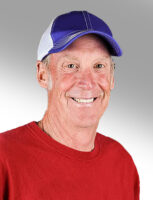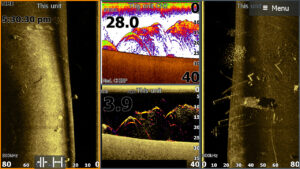Anglers can change chart speed to faster, slower or factory setting. (Photo by Brad Wiegmann).
 Changing Chart Speed for Better Sonar Imaging
Changing Chart Speed for Better Sonar Imaging
by Brad Wiegmann
Fishfinders collect data and display it on a screen and with the exception of live imaging sonar, the imaging scrolls from right to left. Everything you are seeing is the history of what was in the cone under or on the side of the boat depending on the sonar view.
But virtually every unit allows you to vary the speed at which your images scroll across the screen.
Adjusting chart speed does NOT change the short bursts of electrical energy known as pings, which actually create the images you see. It only changes the speed at which it is displayed.
In most cases, the “Default” speed chosen by the manufacturer works best for most anglers. However, by tweaking the chart speed you can achieve better imaging in some cases.
Faster is not always better
when it comes to chart speed.
A general rule of thumb for angler’s setting chart speed is to match the speed of the boat to the number setting. For example, if your boat is moving at 3 mph the chart speed should be set to 3. Going just one number lower than the boat’s speed typically results in the highest resolution of imaging and going 1 or 2 numbers higher will stretch out the fish echoes or may separate them out.

Traditional sonar, side imaging and down imaging with chart speeds too fast will result in imaging with elongated returns and loss of resolution. A good example of this is fish arches in traditional sonar that are longer in length and skinny or by going too fast, two separate schools of game fish become one school. Another example is submerged tree limbs going too fast will not have a sharp image of the branch or game fish suspended in or around the branches.
A chart speed too slow will shrink the data overlaying echoes on top of each other resulting in a blurred imaging in side imaging or down imaging making cover, structure, baitfish or game fish unidentifiable. Traditional sonar the imaging will continue to scroll, but by the image of a game fish, baitfish, structure or cover will be behind the transducer’s cone.
Most touch screen fishfinders allow an angler to scroll back to see recent prior imaging or to mark a waypoint. When exiting the scrolling history or waypoint tool panel the fishfinder will return scrolling at the prior chart speed.
One mode that is not affected by chart speed is mapping or charting mode on some fishfinders. The mapping/charting moves according to boat speed.
But again, as a general rule adjusting your chart speed to closely match your boat speed can often produce the best imagery.
(From Springdale, Arkansas, Brad Wiegmann is a professional photographer, videographer and outdoor writer published in dozens of print and electronic media outlets all across the nation. He is also a well-known guide, podcaster and social media influencer. Learn more about Wiegmann and his lengthy experience and expertise at BradWiegmann.com.)



